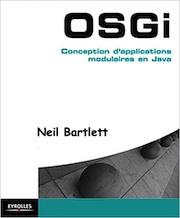
|
FreeComputerBooks.com
Links to Free Computer, Mathematics, Technical Books all over the World
|
|
- Title: CICS and the JVM server: Developing and Deploying Java Applications
- Author(s) Chris Rayns, George Burgess, Scott Clee, Tom Grieve, John Taylor
- Publisher: Vervante (June 24, 2013); eBook (IBM Redbooks )
- Paperback: 406 pages
- eBook: PDF (406 page3) and ePub
- Language: English
- ISBN-10: 0738438332
- ISBN-13: 978-0738438337
- Share This:

|
provides information about the new Java virtual machine (JVM) server technology in IBM CICS Transaction Server for z/OS V4.2. We begin by outlining the many advantages of its multi-threaded operation over the pooled JVM function of earlier releases. The Open Services Gateway initiative (OSGi) is described and we highlight the benefits OSGi brings to both development and deployment.
Details are then provided about how to configure and use the new JVM server environment.
The book continues with a comparison between traditional CICS programming, and CICS programming from Java. As a result, the main functional areas of the Java class library for CICS (JCICS) application programming interface (API) are extensively reviewed.
About the AuthorsN/A
- Advanced Java
- Mainframe Computing
- Introduction to Java, Basic Java
- Enterprise Java and Java EE (J2EE)
 Similar Books:
Similar Books:
-
 Java Application Development for CICS (Chris Rayns, et al)
Java Application Development for CICS (Chris Rayns, et al)
The prime audience of this book is CICS and z/OS system programmers who provide support for Java application development and Java application programmers who need a gentle introduction to Java development for CICS.
-
 Dynamic Proxies in Java (Heinz M. Kabutz)
Dynamic Proxies in Java (Heinz M. Kabutz)
Dynamic proxies are such a tool that we can use it to save thousands of lines of repetitive code with a single class. This book is for intermediate to advanced Java programmers who want to get to "guru" status. It is not suitable for beginners in Java.
-
 The Java Web Scraping Handbook (Kevin Sahin)
The Java Web Scraping Handbook (Kevin Sahin)
This book will teach you how to extract data from any website, how to deal with AJAX / Javascript heavy websites, break captchas, deploy your scrapers in the cloud and many other advanced techniques, using Java programming language.
-
 Naked Objects (Richard Pawson, et al)
Naked Objects (Richard Pawson, et al)
The aim of this book is to introduce you to the concept of designing business systems from naked objects, and to enable you to start building such systems using the Naked Objects framework. It outlines a lightweight methodology and provides a short tutorial.
-
 Java Transaction Design Strategies (Mark Richards)
Java Transaction Design Strategies (Mark Richards)
This book is about how to design an effective transaction management strategy using the transaction models provided by Java-based frameworks such as EJB and Spring. Techniques, best practices, and pitfalls with each transaction model will be described.
-
 Object-Oriented vs. Functional Programming (R. Warburton)
Object-Oriented vs. Functional Programming (R. Warburton)
This book discusses similarities between these programming paradigms and points out that both FP and OOP are actually moving closer toward one another. One prominent example is the use of lambda expressions in Java and other OOP languages.
-
 High-Performance Java Platform Computing
High-Performance Java Platform Computing
Threading and concurrency are crucial to building high-performance Java applications. This book thoroughly demystifies them, helping developers leverage threading and concurrency to solve a wide variety of performance problems.
-
 Docker for Java Developers (Arun Gupta)
Docker for Java Developers (Arun Gupta)
This book introduces basic Docker concepts and explains how to achieve faster startup and deployment of your Java‑based applications, shows how Docker containers can save you many headaches when it comes to packaging, deploying, and scaling your applications.
-
 OSGi In Practice (Neil Bartlett)
OSGi In Practice (Neil Bartlett)
This book is a comprehensive guide to OSGi with two primary goals: first introducing to OSGi concepts with examples, then exploresing numerous practical scenarios and techniques, as well as answering questions.
-
 Building Reactive Microservices in Java (Clement Escoffier)
Building Reactive Microservices in Java (Clement Escoffier)
This book is for developers and architects interested in developing microservices and distributed applications. It does not explain the basics of distributed systems, but instead focuses on the reactive benefits to build efficient microservice systems.





